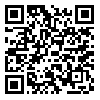BibTeX | RIS | EndNote | Medlars | ProCite | Reference Manager | RefWorks
Send citation to:
URL: http://rjms.iums.ac.ir/article-1-616-en.html
Background & Aim: Jaw cysts are uncommon lesions that frequently behave aggressively and attain a large size. For definite diagnosis clinicoradiopathologic features are needed. Due to a great similarity between historical, clinical and radiological features of jaw cysts, the differentiation of one from another just by regarding one of these data is impossible. Not enough information is available on the relative incidence of jaw cysts in Iranian population. The aim of this study was to ascertain the frequency of jaw cysts and correlation of clinicoradiopathologic features in patients referred to Hazrat Fatemeh Hospital and compare these data with other reported studies. Patients & Methods: This descriptive study used easy method for its sampling and SPSS 10 for data analysis. The files of the pathology diagnosis service at Hazrat Fatemeh Hospital between 1993-2003 were reviewed and all accessions of jaw cysts were listed. Clinical and radiographic data were recorded and microscopic slides re-evaluated according to the most recent World Health Organization(WHO) classification. Results: Out of 64 cases of jaw cysts 62.5% were male. The most frequent jaw cysts were: ameloblastoma(34.4%), dentigerous cysts(20%), odontogenic keratocyst(17.2%), radicular cysts(10.9%), giant cell granuloma(7.8%), aneurysmal bone cyst(3.1%), odontogenic myxoma(3.1%), ameloblastic odontoma(1.6%), and ameloblastic fibroma(1.6%). Ameloblasloma was more frequent in male(59%) and more common in the mandibular ramus. Dentigerous cyst was more frequent in male(92.3%) with age range between 8-55 years and more common in the molar area of mandible. Odontogenic keratocyst was more frequent in male(90%) between 1st and 8th decades of life and posterior part of mandibular body was the more common site. Radicular cyst was more frequent in female(57%) in 4th decade of life and more common in dental zone of mandible. Giant cell granuloma was more frequent in female(60%) in 3rd decade of life and more common in molar zone of mandible. Conclusion: More than 80% of the samples were aggressive jaw cysts(ameloblastoma, dentigerous cyst, keratocyst, odontogeic myxoma, giant cell granuloma including odontogenic cyst, tumor and mesenchymal lesion.) Obtained results showed that aggressive jaw cysts are more common in this study than that of other studies. Furthermore, a precise diagnosis is needed in order to have accurate surgical procedure, prevent recurrence and forestall extensive tissue destruction.





